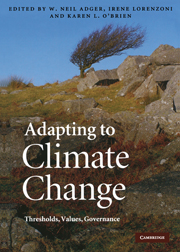Book contents
- Frontmatter
- Contents
- List of contributors
- Preface
- 1 Adaptation now
- Part I Adapting to thresholds in physical and ecological systems
- 2 Ecological limits of adaptation to climate change
- 3 Adapting to the effects of climate change on water supply reliability
- 4 Protecting London from tidal flooding: limits to engineering adaptation
- 5 Climate prediction: a limit to adaptation?
- 6 Learning to crawl: how to use seasonal climate forecasts to build adaptive capacity
- 7 Norse Greenland settlement and limits to adaptation
- 8 Sea ice change in Arctic Canada: are there limits to Inuit adaptation?
- Part II The role of values and culture in adaptation
- Part III Governance, knowledge and technologies for adaptation
- 31 Conclusions: Transforming the world
- Index
- References
7 - Norse Greenland settlement and limits to adaptation
Published online by Cambridge University Press: 31 August 2009
- Frontmatter
- Contents
- List of contributors
- Preface
- 1 Adaptation now
- Part I Adapting to thresholds in physical and ecological systems
- 2 Ecological limits of adaptation to climate change
- 3 Adapting to the effects of climate change on water supply reliability
- 4 Protecting London from tidal flooding: limits to engineering adaptation
- 5 Climate prediction: a limit to adaptation?
- 6 Learning to crawl: how to use seasonal climate forecasts to build adaptive capacity
- 7 Norse Greenland settlement and limits to adaptation
- 8 Sea ice change in Arctic Canada: are there limits to Inuit adaptation?
- Part II The role of values and culture in adaptation
- Part III Governance, knowledge and technologies for adaptation
- 31 Conclusions: Transforming the world
- Index
- References
Summary
Introduction
The end of Norse Greenland sometime in the mid to late fifteenth century AD is an iconic example of settlement desertion commonly attributed to the climate changes of the ‘Little Ice Age’ combined with a generalized failure to adapt (for example, Diamond, 2005). The idea of chronic Norse adaptive failure has been widely accepted, in part because other peoples in Greenland (the Thule Inuit) survived through the period of Norse extinction. Human settlement of Greenland was definitely possible through the climate fluctuations of the thirteenth to seventeenth centuries AD, despite increasingly well-documented changes in temperature, probable growing season, sea ice, storminess and sea level. The Inuit achieved sustainability during this period of instability and change, but the Norse did not. It is assumed there must have been some degree of Norse maladaptation or more constrained limits to their adaptations than those of the Inuit, and the Norse are seen to have ‘chosen extinction’. We suggest that the picture emerging from recent and current research is far more complex, and propose that the Norse had achieved a locally successful adaptation to new Greenlandic resources but that their very success may have reduced the long-term resilience of the small community when confronted by a conjuncture of culture contact, climate change and new patterns of international trade.
The reasons for the final collapse of Norse Greenland are still incompletely understood, but new data from Greenland and across the North Atlantic, combined with changing ideas and developing cognitive frameworks, are refining and deepening our understanding on both adaptation and its limits (Dugmore et al., 2007a; McGovern et al., 2007).
- Type
- Chapter
- Information
- Adapting to Climate ChangeThresholds, Values, Governance, pp. 96 - 113Publisher: Cambridge University PressPrint publication year: 2009
References
- 12
- Cited by



